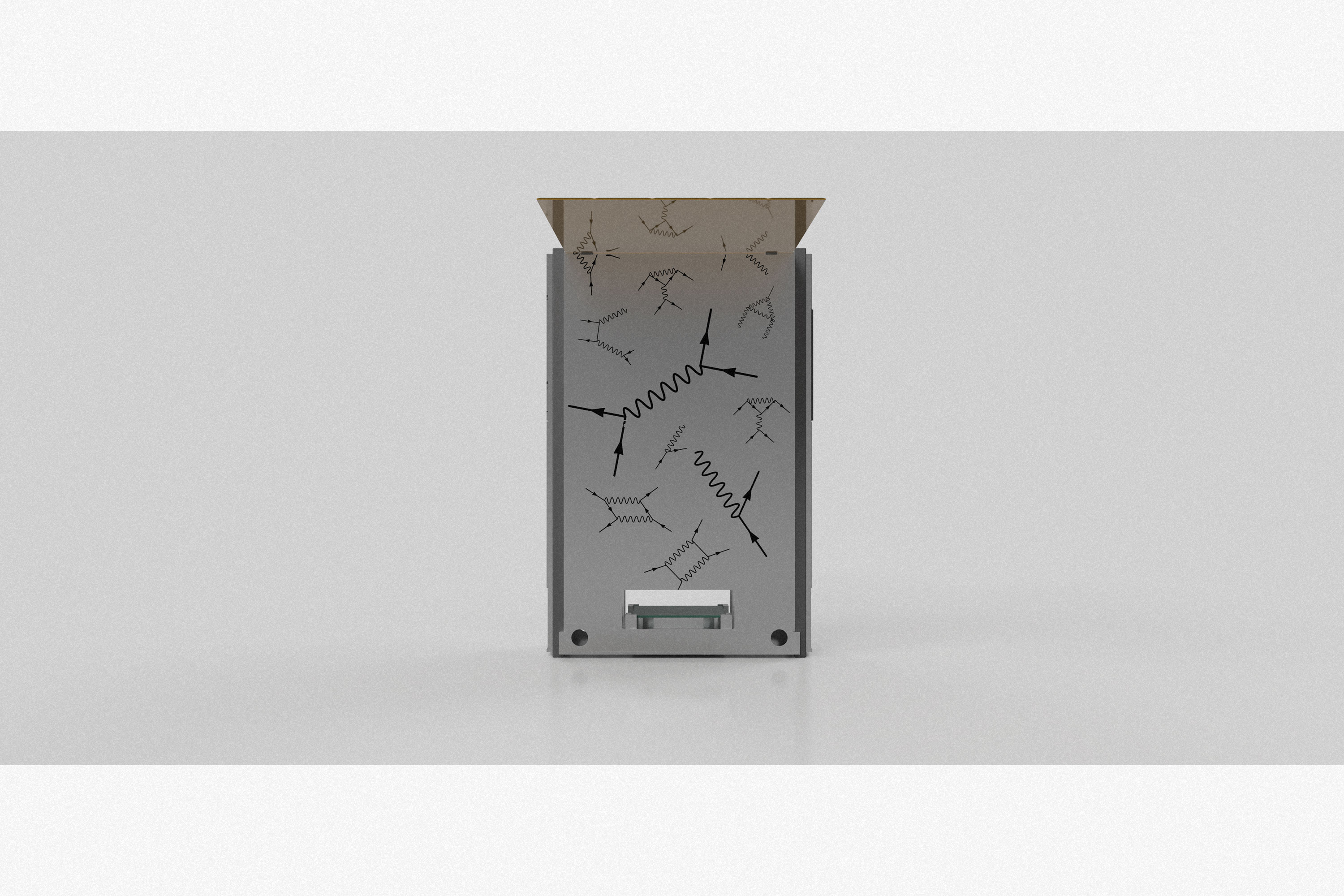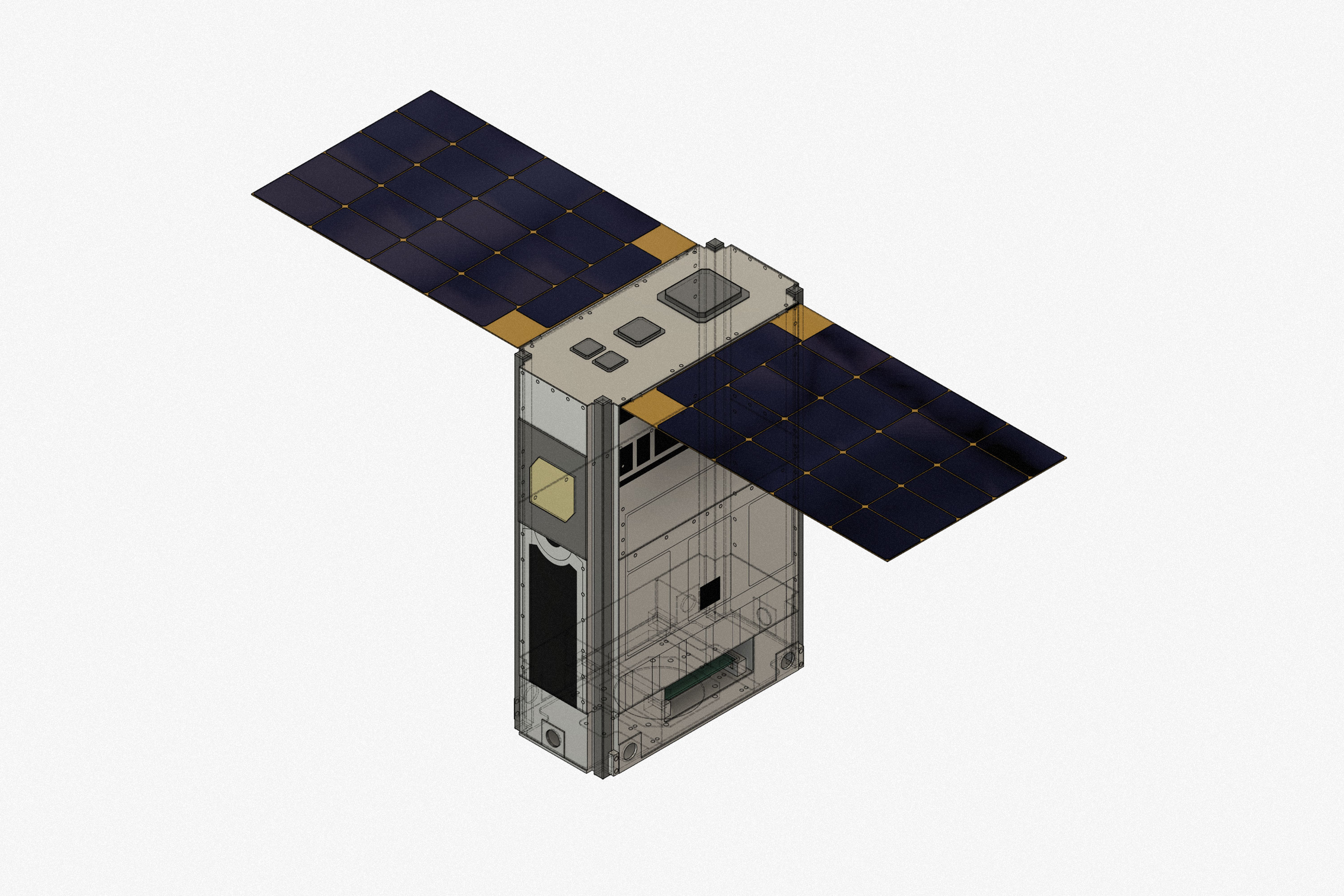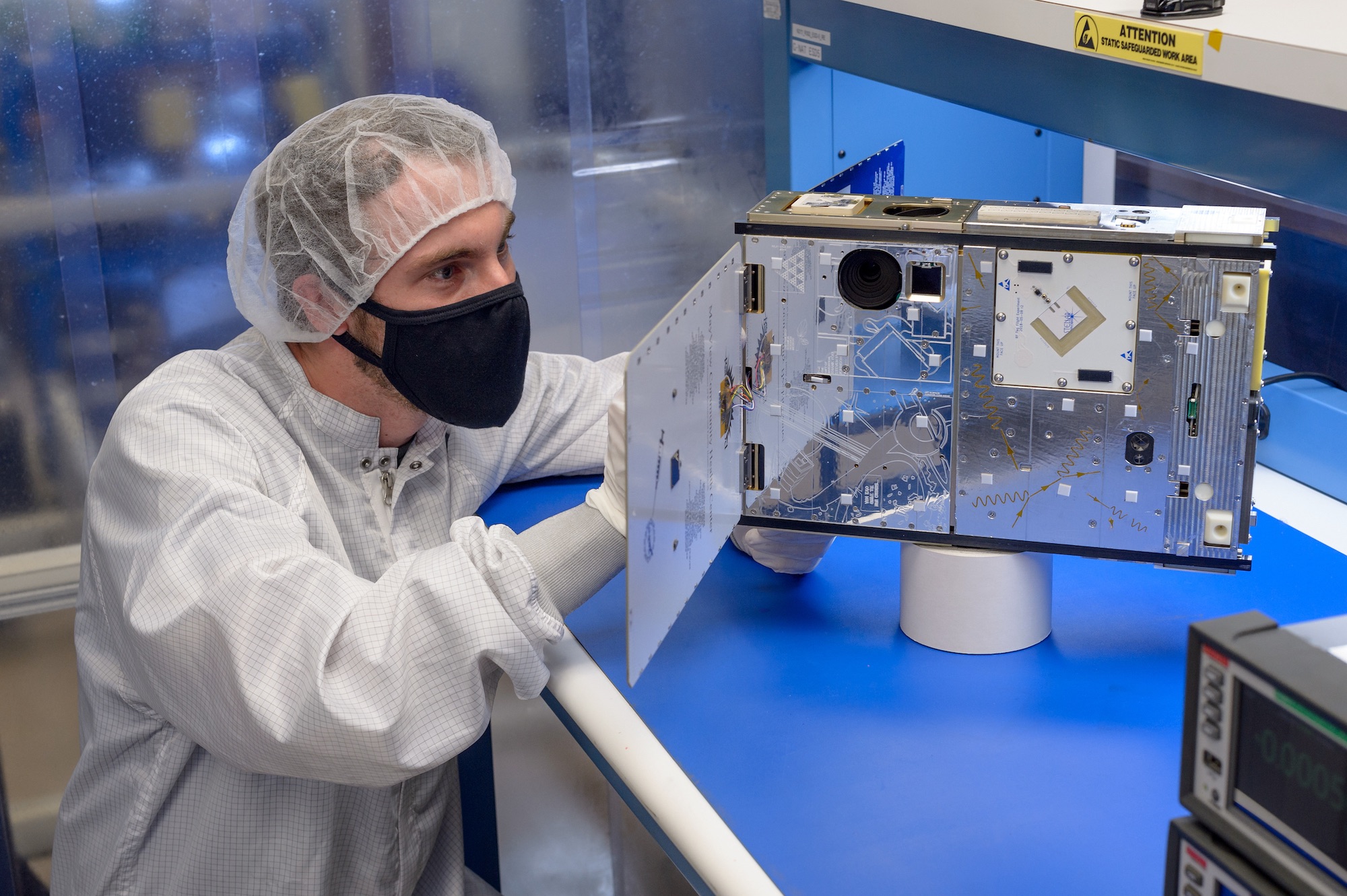
S/C Feynman
Etched diagrams on aluminum spacecraft body.
PACE-1 satellite.
NASA Ames Research Center,
2020

“One of NASA’s newest spacecraft to reach orbit features artwork that is close to home: stylized depictions of Feynman diagrams, laser-etched into the outer emissivity skin of the PACE-1 6U satellite.
The PACE-1 satellite is part of NASA’s Payload Accelerator for CubeSat Endeavors (PACE) Initiative, a project to test a series of potential payloads for cubesats, which are tiny modular satellites. Arno Geens, a designer and former visual strategist at JPL, which Caltech manages for NASA, created an artwork that drew inspiration from diagrams created by the late Richard Feynman, professor of physics and Nobel laureate.
“Feynman developed a uniquely elegant and creative visual language to depict an intrinsically complex process,” Geens says. “His diagrams depict the interaction of subatomic particles, such as the kind that would occur from radiation affecting a satellite’s scientific payload. By honoring them as true works of art, his diagrams directly reflect the satellite’s objective.”
The spacecraft engineering team, the artist, and co-curator Luke Idziak collaborated to determine how to etch art onto the side of the cubesat without affecting its ability to perform its job. “We wanted to find a way to depict invisible things happening inside the spacecraft; to show vanishingly small processes—particle collisions—through an artistic medium that could be accessible to wide audience,” he says.
Idziak sees the artwork as both a continuation of NASA’s legacy of art in space, which includes the Voyager Golden Record, and an homage to the bygone era of objects that are functional and creative, such as illuminated medieval manuscripts.
“Every spacecraft is a custom-built creation, with countless hours of effort distilled into it,” Idziak says. “By including artists in the development process, we have an opportunity to make new spacecraft not only functional, but beautiful and engaging to a wide audience as well.”—ROBERT PERKINS, Caltech Magazine.
This artwork is part of the first orbital art exhibition curated by the Spacecraft Agency for NASA. Other artists in this exhibition are Selby Sohn, Mike Dabro and Steven Johnon.
The Artwork was launched on june 30th 2021 from Cape Canaveral, Florida aboard a SpaceX Falcon 9 rocket and is currently operational in a sun-synchronous orbit.”
The PACE-1 satellite is part of NASA’s Payload Accelerator for CubeSat Endeavors (PACE) Initiative, a project to test a series of potential payloads for cubesats, which are tiny modular satellites. Arno Geens, a designer and former visual strategist at JPL, which Caltech manages for NASA, created an artwork that drew inspiration from diagrams created by the late Richard Feynman, professor of physics and Nobel laureate.
“Feynman developed a uniquely elegant and creative visual language to depict an intrinsically complex process,” Geens says. “His diagrams depict the interaction of subatomic particles, such as the kind that would occur from radiation affecting a satellite’s scientific payload. By honoring them as true works of art, his diagrams directly reflect the satellite’s objective.”
The spacecraft engineering team, the artist, and co-curator Luke Idziak collaborated to determine how to etch art onto the side of the cubesat without affecting its ability to perform its job. “We wanted to find a way to depict invisible things happening inside the spacecraft; to show vanishingly small processes—particle collisions—through an artistic medium that could be accessible to wide audience,” he says.
Idziak sees the artwork as both a continuation of NASA’s legacy of art in space, which includes the Voyager Golden Record, and an homage to the bygone era of objects that are functional and creative, such as illuminated medieval manuscripts.
“Every spacecraft is a custom-built creation, with countless hours of effort distilled into it,” Idziak says. “By including artists in the development process, we have an opportunity to make new spacecraft not only functional, but beautiful and engaging to a wide audience as well.”—ROBERT PERKINS, Caltech Magazine.
This artwork is part of the first orbital art exhibition curated by the Spacecraft Agency for NASA. Other artists in this exhibition are Selby Sohn, Mike Dabro and Steven Johnon.
The Artwork was launched on june 30th 2021 from Cape Canaveral, Florida aboard a SpaceX Falcon 9 rocket and is currently operational in a sun-synchronous orbit.”










On Space Radiation:
Outside the protective cocoon of the Earth’s atmosphere is a universe full of radiation.Radiation is a form of energy that is emitted in the form of rays, electromagnetic waves, and/or particles. In some cases, radiation can be seen (visible light) or felt (infrared radiation), while other forms—like x-rays and gamma rays—are not visible and can only be observed with special equipment. Although radiation can have negative effects both on biological and mechanical systems, it can also be carefully used to learn more about each of those systems.
Space radiation is different from the kinds of radiation we experience here on Earth. Space radiation is comprised of atoms in which electrons have been stripped away as the atom accelerated in interstellar space to speeds approaching the speed of light – eventually, only the nucleus of the atom remains.
Space radiation is made up of three kinds of radiation: particles trapped in the Earth’s magnetic field; particles shot into space during solar flares (solar particle events); and galactic cosmic rays, which are high-energy protons and heavy ions from outside our solar system. All of these kinds of space radiation represent ionizing radiation.
Beyond Low Earth Orbit, space radiation may place astronauts at significant risk for radiation sickness, and increased lifetime risk for cancer, central nervous system effects, and degenerative diseases. It can also tamper with all electronic systems. Research studies of exposure in various doses and strengths of radiation provide strong evidence that cancer and degenerative diseases are to be expected from exposures to galactic cosmic rays (GCR) or solar particle events (SPE).
Earth’s biggest source of radiation is the Sun. The Sun emits all wavelengths in the electromagnetic spectrum (EM). The majority is in the form of visible, infrared, and ultraviolet radiation (UV). Occasionally, giant explosions, called solar flares, occur on the surface of the Sun and release massive amounts of energy out into space in the form of x-rays, gamma rays, and streams of protons and electrons. This is called a solar particle event (SPE). These solar flares can have serious consequences to astronauts and their equipment, even at locations that are far from the Sun.
While non-ionizing radiation is damaging, it can easily be shielded out of an environment as is done for UV radiation. Ionizing radiation, however, is much more difficult to avoid. Ionizing radiation has the ability to move through substances such as electronic components and alter them as it passes through. When this happens, it ionizes the atoms (knocks electrons out of them) in the surrounding material with which it interacts.
Ionizing radiation is like an atomic-scale cannonball that blasts through material, leaving significant damage behind. More damage can also be created by secondary particles that are propelled into motion by the primary radiation particle.
Source: https://www.nasa.gov/analogs/nsrl/why-space-radiation-matters
On Feynman Diagrams:
Feynman diagram, a graphical method of representing the interactions of elementary particles, invented in the 1940s and ’50s by the American theoretical physicist Richard P. Feynman. Introduced during the development of the theory of quantum electrodynamics as an aid for visualizing and calculating the effects of electromagnetic interactions among electrons and photons, Feynman diagrams are now used to depict all types of particle interactions.
A Feynman diagram is a two-dimensional representation in which one axis, usually the horizontal axis, is chosen to represent space, while the second (vertical) axis represents time. Straight lines are used to depict fermions—fundamental particles with half-integer values of intrinsic angular momentum (spin), such as electrons (e−)—and wavy lines are used for bosons—particles with integer values of spin, such as photons (γ). On a conceptual level fermions may be regarded as “matter” particles, which experience the effect of a force arising from the exchange of bosons, so-called “force-carrier,” or field, particles.
At the quantum level the interactions of fermions occur through the emission and absorption of the field particles associated with the fundamental interactions of matter, in particular the electromagnetic force, the strong force, and the weak force. The basic interaction therefore appears on a Feynman diagram as a “vertex”—i.e., a junction of three lines. In this way the path of an electron, for example, appears as two straight lines connected to a third, wavy, line where the electron emits or absorbs a photon. (See the figure.)
Source: https://www.britannica.com/science/Feynman-diagram
Outside the protective cocoon of the Earth’s atmosphere is a universe full of radiation.Radiation is a form of energy that is emitted in the form of rays, electromagnetic waves, and/or particles. In some cases, radiation can be seen (visible light) or felt (infrared radiation), while other forms—like x-rays and gamma rays—are not visible and can only be observed with special equipment. Although radiation can have negative effects both on biological and mechanical systems, it can also be carefully used to learn more about each of those systems.
Space radiation is different from the kinds of radiation we experience here on Earth. Space radiation is comprised of atoms in which electrons have been stripped away as the atom accelerated in interstellar space to speeds approaching the speed of light – eventually, only the nucleus of the atom remains.
Space radiation is made up of three kinds of radiation: particles trapped in the Earth’s magnetic field; particles shot into space during solar flares (solar particle events); and galactic cosmic rays, which are high-energy protons and heavy ions from outside our solar system. All of these kinds of space radiation represent ionizing radiation.
Beyond Low Earth Orbit, space radiation may place astronauts at significant risk for radiation sickness, and increased lifetime risk for cancer, central nervous system effects, and degenerative diseases. It can also tamper with all electronic systems. Research studies of exposure in various doses and strengths of radiation provide strong evidence that cancer and degenerative diseases are to be expected from exposures to galactic cosmic rays (GCR) or solar particle events (SPE).
Earth’s biggest source of radiation is the Sun. The Sun emits all wavelengths in the electromagnetic spectrum (EM). The majority is in the form of visible, infrared, and ultraviolet radiation (UV). Occasionally, giant explosions, called solar flares, occur on the surface of the Sun and release massive amounts of energy out into space in the form of x-rays, gamma rays, and streams of protons and electrons. This is called a solar particle event (SPE). These solar flares can have serious consequences to astronauts and their equipment, even at locations that are far from the Sun.
While non-ionizing radiation is damaging, it can easily be shielded out of an environment as is done for UV radiation. Ionizing radiation, however, is much more difficult to avoid. Ionizing radiation has the ability to move through substances such as electronic components and alter them as it passes through. When this happens, it ionizes the atoms (knocks electrons out of them) in the surrounding material with which it interacts.
Ionizing radiation is like an atomic-scale cannonball that blasts through material, leaving significant damage behind. More damage can also be created by secondary particles that are propelled into motion by the primary radiation particle.
Source: https://www.nasa.gov/analogs/nsrl/why-space-radiation-matters
On Feynman Diagrams:
Feynman diagram, a graphical method of representing the interactions of elementary particles, invented in the 1940s and ’50s by the American theoretical physicist Richard P. Feynman. Introduced during the development of the theory of quantum electrodynamics as an aid for visualizing and calculating the effects of electromagnetic interactions among electrons and photons, Feynman diagrams are now used to depict all types of particle interactions.
A Feynman diagram is a two-dimensional representation in which one axis, usually the horizontal axis, is chosen to represent space, while the second (vertical) axis represents time. Straight lines are used to depict fermions—fundamental particles with half-integer values of intrinsic angular momentum (spin), such as electrons (e−)—and wavy lines are used for bosons—particles with integer values of spin, such as photons (γ). On a conceptual level fermions may be regarded as “matter” particles, which experience the effect of a force arising from the exchange of bosons, so-called “force-carrier,” or field, particles.
At the quantum level the interactions of fermions occur through the emission and absorption of the field particles associated with the fundamental interactions of matter, in particular the electromagnetic force, the strong force, and the weak force. The basic interaction therefore appears on a Feynman diagram as a “vertex”—i.e., a junction of three lines. In this way the path of an electron, for example, appears as two straight lines connected to a third, wavy, line where the electron emits or absorbs a photon. (See the figure.)
Source: https://www.britannica.com/science/Feynman-diagram
︎︎︎ Home